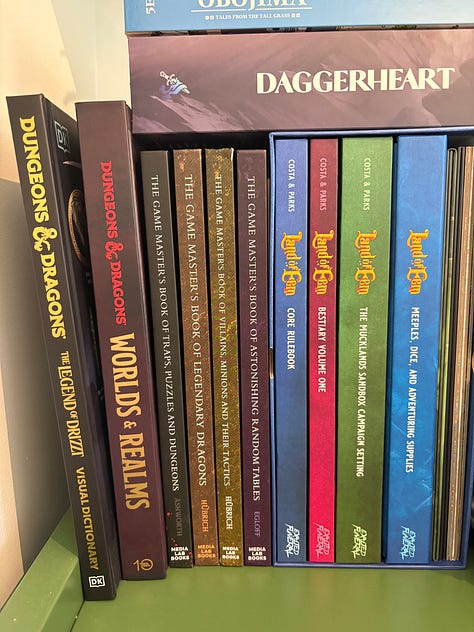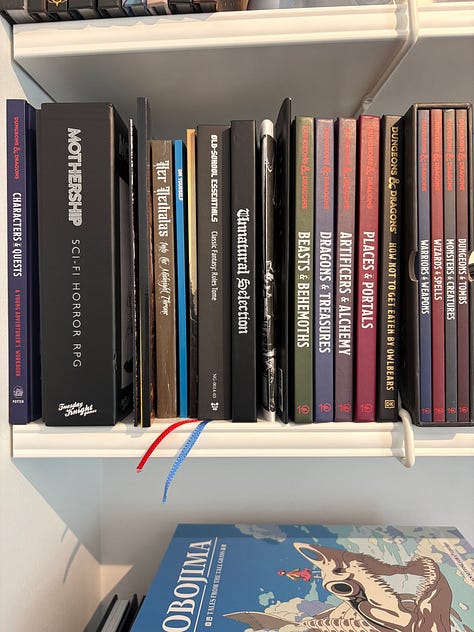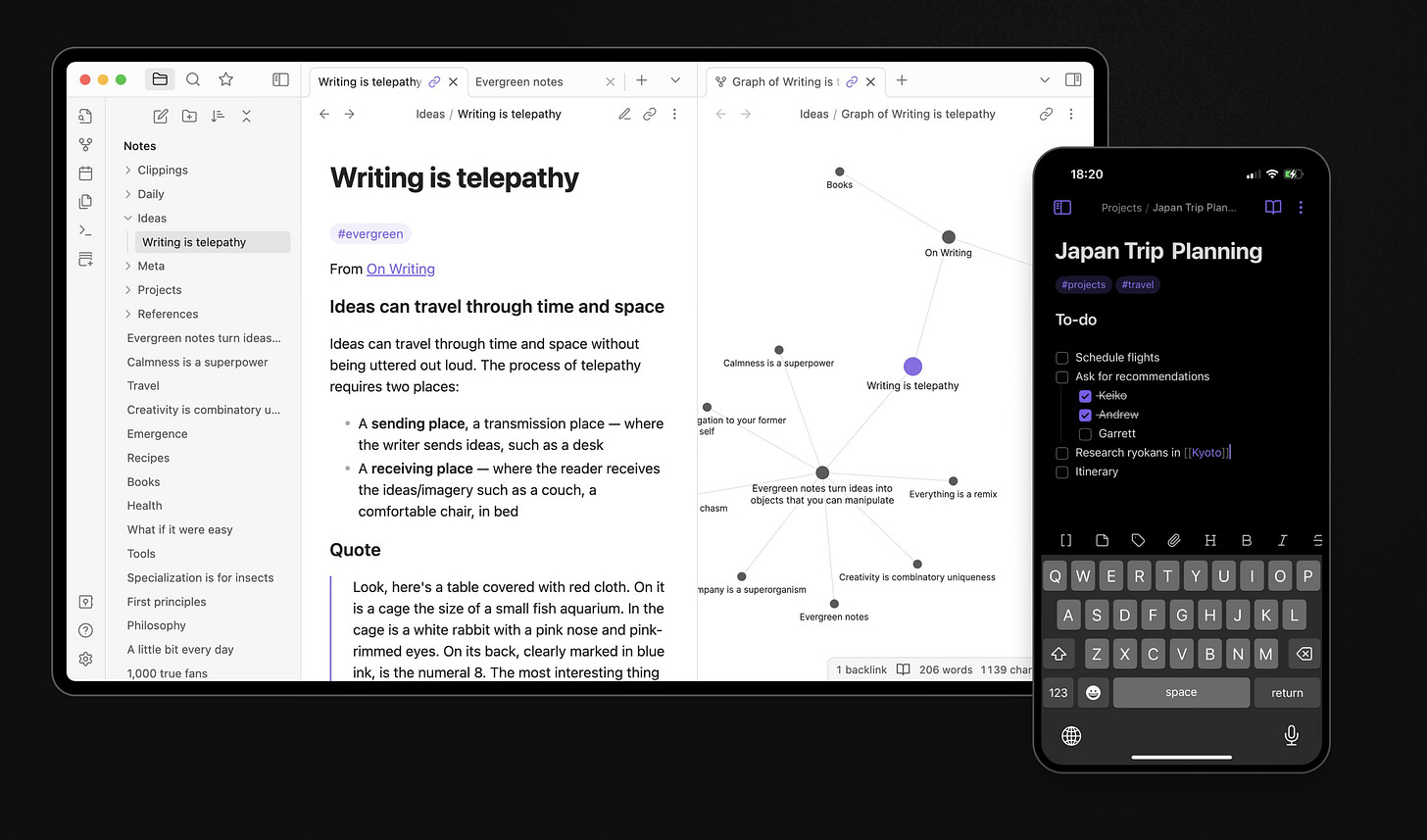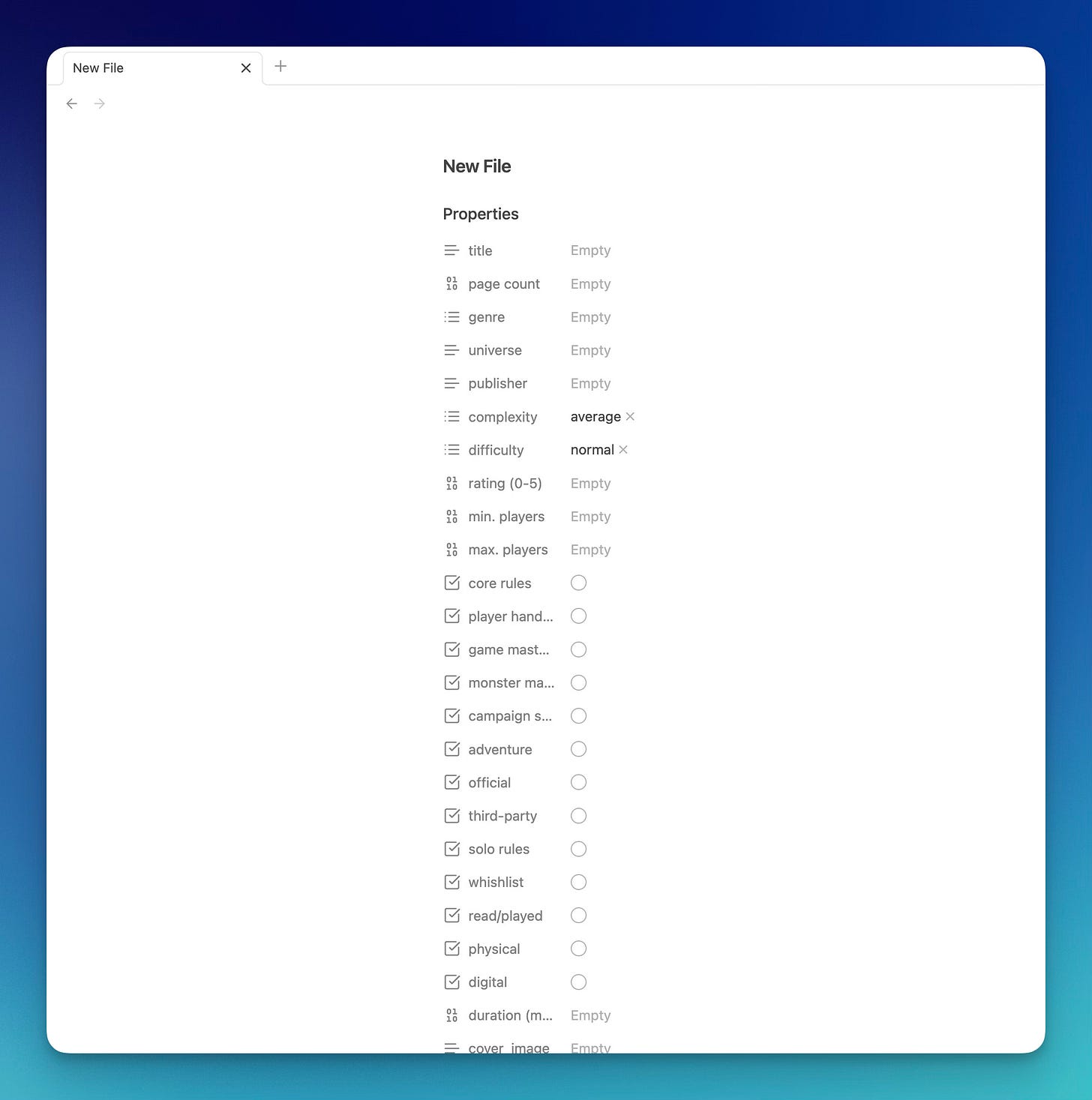How I Organize my RPGs
Bye bye chaos
I've wanted to tackle this project for quite some time, and this week I finally took the plunge.
Over the past few months, I've accumulated an impressive collection of RPG books (too many). I've mentioned in recent posts that I wanted to be more intentional with my purchases—to be mindful of how I spend my money and truly appreciate the books I'm buying.
Impulsive Buying



Here's the pattern I found myself trapped in:
I'd see something that looked cool or interesting and immediately purchase it. I'd start reading, dive in with enthusiasm, but then life would get busy. Before I knew it, another intriguing book would catch my eye, and the cycle would repeat.
The result? A towering collection of books that I'd only read at surface level, at best. This isn't something I'm proud of. I used to be much more dedicated to finishing the books I bought, but over the last few months, I've definitely slipped in that regard.
Taking Control
I decided to take matters into my own hands and find a way to organize everything. I wanted a bird's-eye view of every book I've purchased, owned, and want to read. In my mind, this would give me clarity and allow me to see at a glance what I already own, and maybe would prevent me from impulsively buying something new.
For this task, I chose my favorite app: Obsidian.
Obsidian is a note-taking app built on a wonderful philosophy: "files over app." This means you're never locked into a vendor. If development ever ends, you still own all your files. Nothing is stored on someone else's server—everything is local-first.
The app uses Markdown, an elegant markup language that lets you write text quickly while adding formatting like bold text, headings, callouts, and tables. You rarely need to leave your keyboard because everything works with specific syntax:
Want a level-one heading? Add one hashtag (#)
Second-level heading? Two hashtags (##)
Lists? Simply use dashes (-)
Numbered lists? Use 1. and the numbering increments automatically
The Obsidian Advantage
While many Markdown note-taking apps exist, Obsidian stands out because:
Local-first approach: No internet connection required
File synchronization: Optional subscription for multi-device sync (though you can use OneDrive or iCloud instead)
Extensive plugin ecosystem: Customize the UI and add interesting features
Next-level customization: The possibilities are endless
I use plugins sparingly, though. I want to stay as close as possible to pure notes so that if I ever move my notes elsewhere, they'll look nearly identical to how they appear in Obsidian.
Obsidian Bases
The real game-changer was Obsidian's recently released “Database” feature. This creates table or card views where you can display notes with powerful filtering and sorting capabilities.
Instead of reorganizing notes into folders, I can simply write a note and use YAML properties to make it appear in a specific view.
My Games Setup
I created a database called "Games" that encompasses all types of games: RPGs, video games, board games, and TCGs.
Here's how the system works:
Primary categorization:
category: Set to "games" for all gaming-related notes
subcategory: Specifies the type (RPG, video game, board game, etc.)
For RPG entries specifically, I track:
Title: The book's name
Genre: Fantasy, sci-fi, horror, etc.
Universe: The game system or setting (e.g., "Dungeons & Dragons")
Publisher: Who published it (e.g., "Ghostfire Gaming" for Grim Hollow)
Rating: Personal appreciation scale (0-5)
Wishlist: Boolean for books I want but don't own
Read/Played: Completion status
Physical/Digital: Format ownership
Solo rules: Whether it includes built-in solo play options
Cover image: Visual reference
Path: File URL that opens the PDF location in Finder
Additional flags: Core rules, adventure module, official vs. third-party content
Process
Once I had my template ready, I began the manual entry process:
Audit existing collection: Checked my DriveThruRPG account for forgotten downloads
Centralize files: Moved everything from scattered locations (desktop, macOS Books app, etc.)
into organized iCloud foldersCataloging: Created individual notes for each book with complete metadata
Cover Art: Added cover images via screenshots or photos
Example Entry: Obojima
Take Obojima, for instance—it's a fantasy campaign setting that I own in both physical and digital formats, without built-in solo rules. I capture this information, add a cover image, and suddenly I have a comprehensive database entry that's both searchable and filterable.
The Benefits
So far, this system has proven incredibly rewarding. Now I can instantly answer questions like:
Which books have I actually finished reading or played?
What's available in digital versus physical format?
Which adventure modules haven't I explored yet?
What's currently on my wishlist?
The process has also been eye-opening—I'm discovering just how extensive (perhaps too extensive) my collection has become, and I'm not even finished cataloging everything yet.
What’s Next?
I wanted to share this ongoing project because it perfectly combines two of my favorite things: organizational systems and RPGs. It's been genuinely enjoyable to create order from chaos while rediscovering gems in my collection.
If you're curious about Obsidian, interested in my specific template setup, or have questions about my RPG collection, I'd love to hear from you.
The journey toward intentional collecting and mindful reading continues, but now I have the tools to make this goal reachable.
Get Started with a Demo Vault
I have created a public GitHub repository with the configuration files needed to replicate my setup. You can download it here. Cheers!





Welp, I know what I'm doing instead of working today.
Wait a tick, Obsidian has databases now?
That one of a few reasons I stayed with Notion